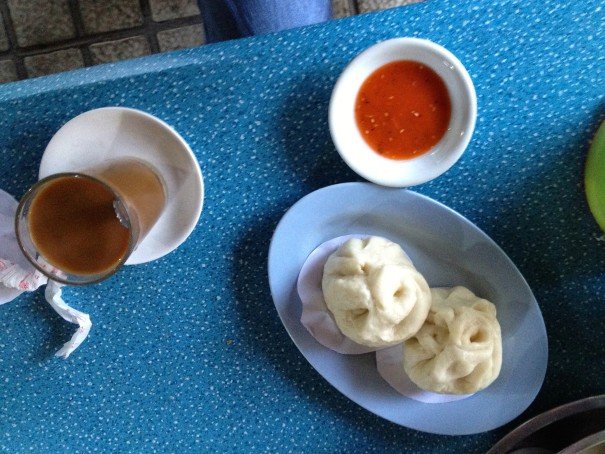
Burmese Independence Buns

Burmese Independence Buns
Though it is late November it is still warm enough to be wearing sandals in northeastern Myanmar. Four of us—myself, Padang my press minder, and two officers from the War Office—sit at a sidewalk breakfast cafe. The grub offered, noodle soup and pork buns, is a reminder of our close proximity to China, whose green mountains lie less than a few miles away across the stony Je Yang river. Yet the differences in the dishes also remind one that he is not in China anymore: the pork buns are served with a sweet, red chili sauce and floating in the noodle soup is a distinctly Burmese concoction of spices: cilantro, mint, ginger and garlic. Instead of tea, everybody is drinking small glass cups of coffee, in either the milky Vietnamese style of condensed sweet milk or the Burmese way, black with a squeeze of fresh lime.
A hulking KIA military truck is parked nearby. It will be used to transport the cooks up to the officers training academy to make lunch for the cadets. Yesterday afternoon, a single 76 mm shell was fired from a Burmese army mountaintop position thirty miles away from the academy, killing 23 young soldiers. After breakfast we will go there to watch the burial.
We are in Laiza, the rebel capital of Kachin state, a town only accessible to foreigners by an illegal border crossing from China. The Kachin Independence Army (KIA), Burma’s second largest armed ethnic group, has designated its turf with a measly border post on the outskirts of a sandy pit in the middle of the jungle. “This is Burma,” my van driver said casually when we reached the outpost. On a rock sticking out of the dirt was painted “KIA” in red lettering. A skinny guard sat heavy-eyed in a booth and waved us in without checking my passport. It didn’t feel like another country. But when a soldier zipped past on a motorcycle, an AK47 slung across his back, then I knew I wasn’t in China anymore.
The KIA, formed in 1961, has been fighting the Burmese army in a slow-burning conflict for over fifty years. A 17-year ceasefire was broken in 2011 when government forces attacked Kachin troops and since then Laiza has been largely cutoff from the outside world. It depends on China for nearly all of its goods but the government makes good money from their own natural resources, mostly teak and jade. The town of over 5,000 has 24/7 electricity, powered by a hydroelectric dam outside the town. It also has schools, two libraries, a movie theater, numerous eateries, shops, hotels and a performance center.
At the cafe we eat casually. My tablemates chat amiably in Kachin. The two war officers wear camo jackets with finely combed hair. The metallic sound of spoon slapping against pot resonates from the open-air kitchen. A dog wanders past the table. One of the officers breaks up his pork buns into a bowl and mixes in the red chili sauce with his chopsticks. I squeeze the last few drops of my lime into my coffee.
After we finish breakfast we all stand up and go our separate ways. Padang and I walk over to his black motorcycle. He mounts it, turns the ignition and pulls out into the street. A motorbike carrying a family of three buzzes past us. The sun is beginning to warm the air but it still cool in the shade. I hop on the motorcycle and we drive off to see the dead.